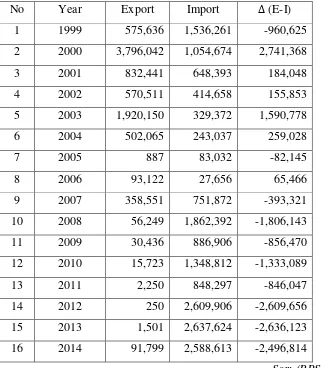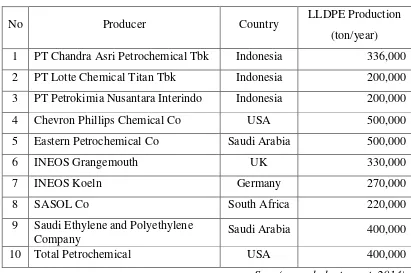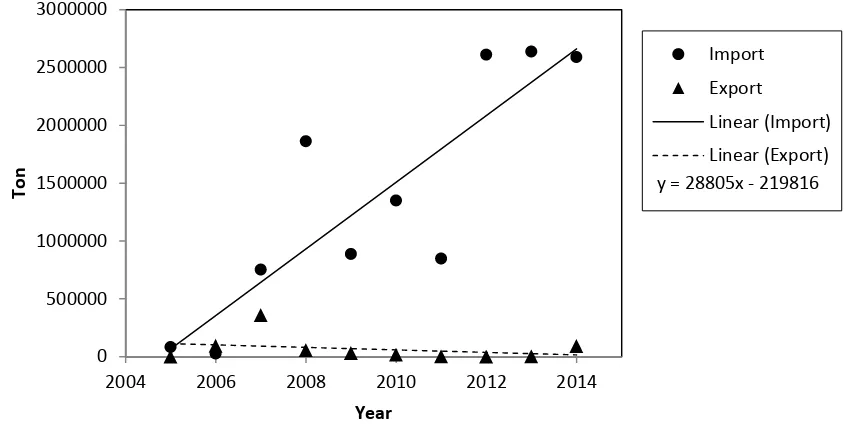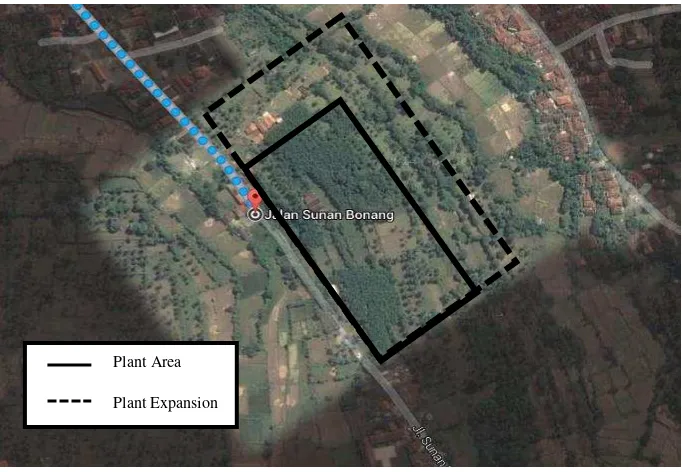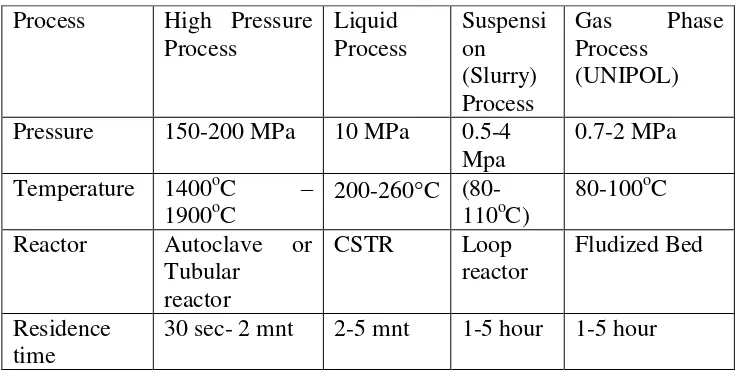CHAPTER I
INTRODUCTION
1.1 . Background
Free trade era has begun in Indonesia, it is required to compete
with other countries in the industry. Industrial development in Indonesia is
very influential on the resilience of the Indonesian economy. Chemical
industry has a role in advancing industry in Indonesia. Innovation of
production processes and the construction of a new plant oriented on
reducing our dependence on foreign products and to increase foreign
exchange is indispensable.
As a developing country, Indonesia undertakes construction and
development in various sectors, such as industry sector. With the
advancement in the industrial sector is expected to improve the welfare of
the community. Governments and companies have to cooperate in the
construction and development in the industrial sector.
Polymers or macromolecules are large molecules built by the
repetition of small parts and simple chemistry. That part is equivalent or
nearly equivalent to the monomer, which is the basic ingredient of
polymer maker. Polyethylene is a thermoplastic polymer that is widely
used in daily life. Polyethylene is insoluble in any solvent at room
temperature. This polymer is also resistant to acids and bases but cannot
be broken by concentrated nitric acid.
Polyethylene’s name is derived from its constituent monomers,
ethylene. Polyethylene was first synthesized accidentally of heating
diazomethane by German chemist Hans von Pechmann named in 1898.
By industry, polyethylene was first synthesized by EW Fawcett in 1936 in
the laboratory of Imperial Chemical Industries, Ltd. (ICI), in the UK on an
unexpected trial, polyethylene form by ethylene reaction at pressure
introduced commercially, and the first ethylene polymer is traded with a
low density polyethylene and high pressure. After experience growing the
production of low-density polyethylene expanding rapidly. In 1953,
Ziegler managed to find a way of making it organometallic polyethylene
and a year later successfully it was produced. Polyethylene produced by
the Ziegler without big pressure polyethylene. Until now, polyethylene is
the type most widely produced polymer.
The increase of chemical industry in Indonesia and in the world,
affect the increase of raw materials. Due to a lack of investors engaged in
the industrial sector and raw material shortages, Indonesia's dependence on
imports is increasing, one of which is importedis polyethylene products.
PT. Chandra Asri Petrochemical was in public exposure to the 2012
annual report of the issuer's press conference. Polyethylene gives 50% of
the revenue of 2011. Based on data from Nexant, total demand growth
Polyethylenewas expected more than 4% in the 2012-2018. While the
capacity of the plant is 336,000 tones / year of data Nexant, total demand
growth forecast for Polyethylene in Indonesia of 4.6% from the period of
2012-2018 (estimate) by increasing the national requirement. Without new
investment and increased utilization of existing production capacity, the
industry is threatened not to develop.
The rapid development of industrial process technologies to
produce products as raw material for polyethylene is pushing to establish
this industry. The establishment of the polyethylene plant in Indonesia is
expected to provide the following benefits:
a. The present of LLDPE industry will reduce the need for imports while is
likely to increase each year so it will save foreign exchange and reduce
dependence on other countries.
b. Establishment of LLDPE is opportunities for the development of the
industry with LLDPE raw materials such as plastic films, wrapping
c. Establishment of LLDPE plant will create jobs in order to improve
human resources.
d. The increase investors in the country, especially the polymer industry
1.2. Design Capacity
In determining the design capacity of the polyethylene plant, there are
several considerations i.e. the capacity of the existing plant, availability of raw
materials, estimated product needs and total import and export products. The Indonesia’s Export and Import LLDPE Data 1999-2013 (unit: tons / year) can be seen in Table 1.
Table 1. Export import BPS data (tons)
No Year Export Import ∆ (E-I)
1 1999 575,636 1,536,261 -960,625
2 2000 3,796,042 1,054,674 2,741,368
3 2001 832,441 648,393 184,048
4 2002 570,511 414,658 155,853
5 2003 1,920,150 329,372 1,590,778
6 2004 502,065 243,037 259,028
7 2005 887 83,032 -82,145
8 2006 93,122 27,656 65,466
9 2007 358,551 751,872 -393,321
10 2008 56,249 1,862,392 -1,806,143
11 2009 30,436 886,906 -856,470
12 2010 15,723 1,348,812 -1,333,089
13 2011 2,250 848,297 -846,047
14 2012 250 2,609,906 -2,609,656
15 2013 1,501 2,637,624 -2,636,123
16 2014 91,799 2,588,613 -2,496,814
From Table 1, Indonesia at 1999- 2002 can export the LLDPE more than
500.000 ton, but after 2003 the export product is decreasing until below
10.000 more over at 2005 and 2012 under 1.000 ton.The decreasing of export
cause by increasing local requirement of LLDPE.
On the other hand, the import data (Table 2) show in the 2004 our
requirement increase. Import requirement of LLDPE always above
500.000 ton/year, without additional domestic production the number of
import will be increased.
Total domestic production showed at Table 3 is 736.000 ton/year from
3 big factories in Indonesia. In reality that production can’t solve requirement
if Indonesia requirement.
Table 2. Domestic and International production
No Producer Country LLDPE Production
(ton/year)
1 PT Chandra Asri Petrochemical Tbk Indonesia 336,000
2 PT Lotte Chemical Titan Tbk Indonesia 200,000
3 PT Petrokimia Nusantara Interindo Indonesia 200,000
4 Chevron Phillips Chemical Co USA 500,000
5 Eastern Petrochemical Co Saudi Arabia 500,000
6 INEOS Grangemouth UK 330,000
7 INEOS Koeln Germany 270,000
8 SASOL Co South Africa 220,000
9 Saudi Ethylene and Polyethylene
Company Saudi Arabia 400,000
10 Total Petrochemical USA 400,000
Sor: (annual plant repot, 2014)
Europe, North America and Middle East had been produced LLDPE in the
200ktonprofitable then if Indonesia use the technology we can fulfill the
domestic demand of LLDPE.
Figure 1. Export import of polyethylene 2005-2014
Predicted that every year LLDPE demand rise 3% (ICN, 2008), so that the
government and the company continue to improve its LLDPE production.
Using comparison BJS data from 10 year ago until now (2005-2014) we got
Graph 1., for namely 2005 as 1 and 2014 as 10 point at X direction, we get
y = 28805X-219816 for Import and y = -10857X -124789, after that if we
want to operation the new plant in 2027 (22 point) we get import requirement
y = 28805(22)-219816 = 413.894 Ton/year or simply become
400.000 tones/year.
1.3. Location Selection
The location of Cilegon was chosen based on the following
considerations primary factors and secondary factors. The primary factors
directly affect the main purpose of the plant which includes the production
and distribution of products and arranged according to the kind and quality,
time and place required by customers at an affordable price level while the
plant is still obtain a reasonable profit.
1.3.1. Primary factors
There are several factors that must be considered to determine the
location of the plant to build in order to be technical viable and
economically profitable. The location of a plant has considerable influence
on the smoothness of industrial activity. Linear low density polyethylene
factory is planned to be established in the plant planning location in
Industrial Area Cilegon, with the following considerations.
a. Sources of raw materials
The raw material is a major factor in determining the location of the
plant. Polyethylene factory will be set up in the industrial area of
Cilegon exactly at St. Sunan Bonang with 200m2 area, as close to the harbor as a means of trading venues, ethylene was sent from PT.
Chandra Asrithat just + 3 km from our plant area and catalyst imported
from PT. Shelll Company Ltd. Type Super High Activity Catalyst
(SHAC) 201.
b. Market Share
Cilegon is a strategic area for the establishment of a plant because it is
a big city and the center of trade and business in Indonesia.
c. Facilities and transport
The place of Cilegon, plant established with consideration of the case
of transportation. Cilegon is an industrial city that land and sea
transportations can be reached easily. For sea transportation we can use
Banten dock and land transportation we can use st. Letnan Jendral R.
Suprapto as major way.
d. Labor
Labors supply in Cilegon is not difficult because of the year-over-year
e. Utility
The location in the beach is a source of water that is needed for system
utilities. Industry’s Cilegon region also has support facilities in the
operation of a plant that is electricity and clean water (a vital means for
a factory), thereby living plant hire supplies the facility.
Figure 2. Screen shoot of plan plant location
1.3.2. Secondary factors
a. Plant Expansion
Plant establishment should consider the plant expansion plans over the
next 10 or 20 years, because the expansion in region, the plant is not
difficult in finding land for the company.
b. Characteristics of The Location
Location factory is located on the waterfront in and protected small
islands in front of the beach to be calm and avoid big waves.
c. Government Policy
According with government policy Cilegon City will develop the
industry as a facilitator, the Government would provide easiness in
licensing, tax, and others related to the technical implementation of the
establishment of a factory.
d. The available of facilities and services for general industry
The purpose of the service industry here is the workshop industry and
other public facilities such as hospitals, schools and places of worship.
e. Level of tax and labor laws
For areas that will advance society typically impose waivers, as well as
in Indonesia. Cilegon status as an industrial area, making the location
of the enacting relieves that this reduces the fixed expenses that must
be paid (taxes), while the law on labor is still accepted by the
company.
f. Attitude Surrounding Communities
Publics’ attitude is about quite openly in the presence of a new plant. It is driven partly because of an increase in the welfare of the community
after the factories stand.
g. Waste Plant
Waste water from the process can be channeled back into the sea to be
processed first in Waste Water Treatment to meet environmental
1.4. Literature Review
1.4.1. Type of process
Polymerization of ethylene large molecular mass polymers was
first performed by Fawlet and Gibson Ltd. in England in 1933 using
high-pressure techniques. This study was followed by Zeigler and Natta, 1953,
which found the low-pressure process.
Polyethylene products are often call polythene, based on the
density and weight of its constituent molecules, the basic groups name are
Low Density Polyethylene (LDPE), Medium Density Polyethylene
(MDPE) and High Density Polyethylene (HDPE). Our concern about
LLDPE, several methods for producing the LLDPE, namely
(Akers, 2010):
a. High Pressure Process
Two reactors available for this process are autoclave reactor and
jacketed tube reactor. Reaction proses condition is at Temperature
1400– 1900oC, Pressure 150-200 Mpa and residence time 30-60 seconds. From safety aspect, this process has no advantages.
b. Liquid Process
This process was developed by DuPont Co.The raw material of
ethylene dissolved in diluents, such as cyclohexane and pumped into the
reactor at 10 MPa. The reaction is adiabatic and reaction temperature at
200-260 C. Feed mixture containing 25% by weight and 95% is
converted into polyethylene, polyethylene solution out of the reactor
treated by deactivating agent and passed on bed-bound alumina catalyst
which is absorbed (Kirk and Othmer, 1981).This process is slowly being
replaced by gas process, in terms of safety and production efficiency gas
c. Suspension (Slurry) Process
The formation of polyethylene suspended in a hydrocarbon diluent
to first patented by Ziegler. At a certain pressure Ziegler catalyst (titanium
alkyl aluminum) can produce high yields, decreasing the temperature
(80-1100oC) and the pressure (0.5-4 Mpa) with Diluent hexane, this proses is usually called Philip type.
d. Gas Phase Process (UNIPOL)
The reaction system consists of a fluidized bed reactor, acycle gas
compressor and cooler, and product dischargetanks. Ethylene,
co-monomers and a recycle stream fromthe vent recovery system are fed
continuously to thereactor. Polyethylene is removed from the reactor by
thedischarge tanks and sent to a purger where interstitial and dissolved
hydrocarbons are stripped from the resinand are sent to the vent recovery
system. The purgedresin is sent to the pelleting system. Pressure operation
process is 0.7-2 Mpa and temperature reaction process is 80-100oC.
Table 3. Polyethylene process production
thermoplastic, which is product of the polymerization reaction of ethylene
conditions. Polyethylene is a polymer compound thermoplastic that has
heat resistant properties, high tensile strength and insoluble in organic
solvents. Polyethylene is widely used in industry as a raw material in
various plastic industries.
LLDPE is chosen as main product, LLDPE has advantage.
Excellent resistance to dilute and concentrated Acids, Alcohols, Bases and
Esters, good resistance to Aldehydes, Ketones and Vegetable Oils, limited
resistance (moderate attack suitable for short term use only) to Aliphatic
and Aromatic Hydrocarbons, Mineral Oils and Oxidizing Agents and Poor
resistance and not recommended for use with Halogenated Hydrocarbons.
LLDPE is commonly used for food, plastic packaging and bottles. The
mechanical properties of LLDPE is kind of strong, transparent, flexible
and somewhat greasy surface, at a temperature of 60 degrees is very
resistant to chemical reactions, power protection against moisture quite
well, can be recycled and good for items that require flexibility but strong.
The goods is made from LLDPE is difficult to destroy, but still good for
the food because it is difficult to react chemically with foods that are
packed with this material.
1.4.3. Physical properties of raw ,aterials and products
A. Physical properties of raw materials
- Ethylene
Physical properties at 1Atm
Phase : Gas
Color : Colorless
Molecular Weight : 28.06 g/mole
Molecular formula : C2H4
Boiling point (1atm) : -103.77oC
B. Physical properties of supporting material
-Titanium Tetrachloride (TiCl4)
Phase : Liquid (Fuming liquid)
Color : Colorless to light yellow
Odor : Pungent. (Strong.)
Molecular Weight : 189.73 g/mole
Boiling Point (1atm) : 136.4°C
Melting Point (1atm) : -24.1°C
Specific Gravity : 1.726 (Water = 1)
Vapor Pressure : 10 mm of Hg (@ 20°C)
Vapor Density (1atm) : 6.6 (water = 1)
(Nist, 2014)
-Triethylaluminum (TEAL)
Phase : Liquid
Color : Colorless
Odor : Odorless
Molecular Weight : 114.17 g/mol
Chemical Formula : C6H15Al
Boling Point (1atm) : 186°C
Melting Point (1atm) :-52°C
Flammability : Extremely flammable
Specific gravity (@ 25 °C) : 0.832
Viscosity (@ 25 °C) :2.5 MPa
Solubility in water : Reacts violently
-Hydrogen
Phase : gas
Color : Colorless
Odor : Odorless
Molecular Weight : 2.016
Chemical Formula : H2
Boiling Point (1 atm) : -252.8OC
Freezing Point (1atm) : -259.2 OC
Gas Density (70 F and 1 atm) : 0.08342 kg/m3
Solubility In Water : 0.019(Vol/Vol At (15.6 OC))
Specific Volume :11.99 m3/kg
(Nist, 2014)
-Butene-1
Physical properties at 1Atm
Phase : Gas
Color : Colorless
Molecular Weight : 56.108
Molecular formula : C4H8
Freezing Point (1atm) : -185.3°C, -301.6◦F
Boiling Point (1atm) : -6.5°C, 20.7 °F
Vapor Pressure : 162KPa (Gauge), 23.5 Psig @ 21.1°C
Specific Volume :0.418 M3/Kg, 6.7Ft3/Lb @ 1 atm, 21.1°C
C. Physical properties of product
-Linear Low Density Polyethylene
Phase : Solid pellets
Color : Colorless
Odor : negligible
Density(1atm) : 0.910 - 0.940
Melting Point (1atm) : 120~1306oC
Flash Point (1atm) :340oC
Decomposition Temperature :>400oC
Spontaneous Temperature : 3406
Solubility In Water : Insoluble
(Nist, 2014)
1.4.4. Process Overview
Raw material of ethylene, Co-monomer, Co-catalyst and Hydrogen are
mixed through the pipe toward the fluidized bed reactor with operating conditions
of 75°C and 25Atm. TiCl4 catalyst is introduced to the reactor, the conversion of
reaction per pass is 5%.The main reaction is ethylene production.
Unreacted ethylene is recycled to the reactor from the top of the reactor
however the pressure and temperature conditions are adjust using a compressor
and HE period to mix again with fresh feed. Polyethylene products formed flowed
into purge bin to remove the residual entrained. Polyethylene then flowed into
